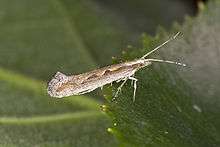Plutellidae
The Plutellidae are a family of moths commonly known as the diamondback moths, named after the diamondback moth (Plutella xylostella) of European origin. Some authors consider this family to be a subfamily of the Yponomeutidae, but it is usually considered to be a family in its own right, and have three subfamilies, Plutellinae, Praydinae, and Scythropiinae.[1]
| Plutellidae | |
|---|---|
 | |
| Diamondback moth (Plutella xylostella) | |
| Scientific classification | |
| Kingdom: | |
| Phylum: | |
| Class: | |
| Order: | |
| Suborder: | |
| Infraorder: | |
| (unranked): | |
| Superfamily: | |
| Family: | Plutellidae Guenee, 1845 |
| Genera | |
|
See text. | |
| Diversity | |
| About 200 species | |
| Synonyms | |
| |
Characteristics
Moths in this family are small to medium in size with wingspans ranging from 7 to 55 mm (0.3 to 2.2 in). The head usually bears smooth scales and the antennae are often thickened in the middle. The wings are elongated and the hindwings often bear long fringes. The forewings often appear to be sickle-shaped because of the arrangement of the fringes. The colouring is generally drab, with various banding and marking. The adults are mostly nocturnal or crepuscular. The larvae feed on the surfaces of leaves which they skeletonise. The host plants vary, but many are in the family Brassicaceae. Some species are economic pests, especially Plutella xylostella and those in the genus Prays.[1]
Genera
- Angoonopteryx Moriuti, 1983
- Anthonympha Moriuti, 1971
- Araeolepia Walsingham, 1881
- Arrhetopista Meyrick, 1936
- Automachaeris Meyrick, 1907
- Bahrlutia Amsel, 1935
- Cadmogenes Meyrick, 1923
- Calliathla Meyrick, 1931
- Charitoleuca Meyrick, 1938
- Charixena Meyrick, 1920
- Circoxena Meyrick, 1916
- Conopotarsa Meyrick, 1913
- Diastatica Meyrick, 1938
- Diathryptica Meyrick, 1907
- Dieda Diakonoff, 1955
- Dolichernis Meyrick, 1891
- Doxophyrtis Meyrick, 1914
- Eidophasia Stephens, 1842
- Endozestis Meyrick, 1933
- Eudolichura Clarke, 1965
- Genostele Walsingham, 1900
- Gypsosaris Meyrick, 1909
- Helenodes Meyrick, 1913
- Hyperxena Meyrick, 1882
- Lepocnemis Meyrick, 1913
- Leuroperna Clarke, 1965
- Lunakia Klimesch, 1941
- Niphodidactis Meyrick, 1938
- Orthenches Meyrick, 1885
- Orthiostola Meyrick, 1927
- Paraxenistis Meyrick, 1919
- Phalangitis Meyrick, 1907
- Philaustera Meyrick, 1927
- Phylacodes Meyrick, 1905
- Pliniaca Busck, 1907
- Plutella Schrank, 1802
- Prays Hübner, 1825
- Proditrix Dugdale, 1987
- Protosynaema Meyrick, 1885
- Psychromnestra Meyrick, 1924
- Rhigognostis Zeller, 1857
- Scaeophanes Meyrick, 1932
- Scythropia Hubner, 1825
- Spyridarcha Meyrick, 1913
- Stachyotis Meyrick, 1905
- Tonza Walker, 1864
- Tritymba Lower, 1894
- Zarcinia Chretien, 1915
Excluded genera and species
The fungus moth Erechthias niphochrysa was also once included here, as a distinct genus Acrocenotes.
The family Acrolepiidae (including the genera Acrolepia, Acrolepiopsis, and Digitivalva) is sometimes included in the Plutellidae.
References
- Capinera, John L. (2008). Encyclopedia of Entomology. Springer Science & Business Media. p. 1206. ISBN 978-1-4020-6242-1.
| Wikispecies has information related to Plutellidae |
| Wikimedia Commons has media related to Plutellidae. |
- Mey, W, 2011: New and little known species of Lepidoptera of southwestern Africa. Esperiana Buchreihe zur Entomologie Memoir 6: 146-261.
- Mey, W, 2012: Phrealcia steueri n. sp. und P. friesei n. sp. - zwei neue Arten einer disjunkt verbreiteten Gattung (Lepidoptera, Ypsolophidae). Entomologische Nachrichten und Berichte 56:53- 57.
- Pitkin, B. & P. Jenkins. Butterflies and Moths of the World: Generic Names and their Type-species. Natural History Museum..
- Sohn, J.-C. & J.A. Lewis, 2012: Catalogue of the type specimens of Yponomeutoidea (Lepidoptera) in the collection of the United States National Museum of Natural History. Zootaxa 3573: 1-17. Abstract: .